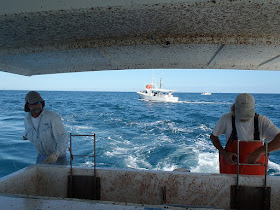
Yesterday, I had the privilege of accompanying Captain Tom Marvel, a commercial fishermen out of Naples, FL on a trip to fish for king mackerel. King mackerel, or kingfish are a coastal pelagic species, which means they live in the open water near the coast. They are also highly migratory. In the Gulf of Mexico they spend their winter months in the waters off south Florida, and migrate to the northern Gulf during the spring. We only had to travel approximately 20 miles offshore to find them yesterday, but Captain Marvel said sometimes he has to travel as far as 50/60 miles. King mackerel are targeted by both the recreational and commercial sector. Recreational fishermen tend to target the larger older fish, where commercial fishermen often look for the largest concentrations of these schooling fish to maximize their catch. The commercial and recreational king mackerel fishery is highly regulated and the population is neither overfished nor experiencing overfishing in the Gulf.
King mackerel is actually one of Collier County's largest commercial finfish fisheries based on landings. In the 2009/2010 season over 347,000 pounds of kingfish were landed by local commercial fishermen. This only makes up a small percentage, though, of what is landed by commercial fishermen in other parts of Florida. The statewide total during the same year was over 5.4 million pounds! Ironically, as much kingfish that is landed in Collier, most of it is shipped elsewhere. A few local vendors carry it, but it isn't generally available. Captain Marvel told me most of what he lands gets shipped up to New York and other parts of the northeast United States.
If you have never tried king mackerel, I suggest you try it. It is a lean fish that has a moderate texture, dark meat and full flavor. It is also low in fat and is a very good source of protein, riboflavin, niacin, vitamin B12, and selenium. Keep in mind that king mackerel may contain amounts of methylmercury in excess of the FDA's recommended limit for mothers, moms-to-be, and young children.
Enjoy the pictures:
 |
| One of several boats fishing with us. Notice the outriggers extending from the boat. They use these to troll for the mackerel. Trolling is one of the main methods to commercially catch king mackerel. Gillnetting in federal waters is also allowed. |
 |
| Captain Tom Marvel (left) and his first mate Allen (right) hauling in fish at the back of their boat. |
 |
| Captain Marvel dehooks a fish, which goes straight into the cooler |
 |
| Most remarkable to me was how close the boats got to one another while fishing. The boat circle around one another in close proximately. Captain Marvel told me the boats are supposes to circle to the right to reduce the chances of collision. |
 |
| All of the orange and red colors on the depth finder indicate a school of kingfish. Fish on! |
 |
| As soon as fish are brought in by hand, they are immediately placed in a cooler. |
 |
| Allen dropping a King into the cooler. |
 |
| When the boat gets into a school of mackerel, the fishing can be very intense. The fishermen work very quickly to retrieve their lines, release their fish, and throw the line back into the water for more fishing. |
 |
| Keeping the fish cold is important. The first mate periodically places ice over the fish and creates a slush to maintain quality. |
 |
Once all of the fish are caught for the day, the captain and first mate gut each fish one by one.
|
 |
| A final layer of ice is put over the gutted fish. In all, the 2-man team hauled in approximately 1200 pounds of fish. Their daily limit is 1250 pounds. |
 Yesterday, I had the privilege of accompanying Captain Tom Marvel, a commercial fishermen out of Naples, FL on a trip to fish for king mackerel. King mackerel, or kingfish are a coastal pelagic species, which means they live in the open water near the coast. They are also highly migratory. In the Gulf of Mexico they spend their winter months in the waters off south Florida, and migrate to the northern Gulf during the spring. We only had to travel approximately 20 miles offshore to find them yesterday, but Captain Marvel said sometimes he has to travel as far as 50/60 miles. King mackerel are targeted by both the recreational and commercial sector. Recreational fishermen tend to target the larger older fish, where commercial fishermen often look for the largest concentrations of these schooling fish to maximize their catch. The commercial and recreational king mackerel fishery is highly regulated and the population is neither overfished nor experiencing overfishing in the Gulf.
Yesterday, I had the privilege of accompanying Captain Tom Marvel, a commercial fishermen out of Naples, FL on a trip to fish for king mackerel. King mackerel, or kingfish are a coastal pelagic species, which means they live in the open water near the coast. They are also highly migratory. In the Gulf of Mexico they spend their winter months in the waters off south Florida, and migrate to the northern Gulf during the spring. We only had to travel approximately 20 miles offshore to find them yesterday, but Captain Marvel said sometimes he has to travel as far as 50/60 miles. King mackerel are targeted by both the recreational and commercial sector. Recreational fishermen tend to target the larger older fish, where commercial fishermen often look for the largest concentrations of these schooling fish to maximize their catch. The commercial and recreational king mackerel fishery is highly regulated and the population is neither overfished nor experiencing overfishing in the Gulf.











No comments:
Post a Comment